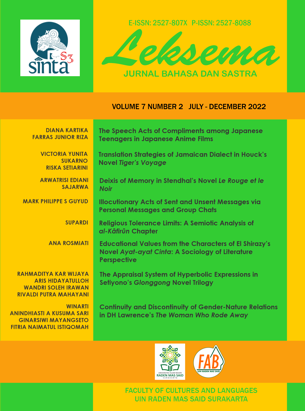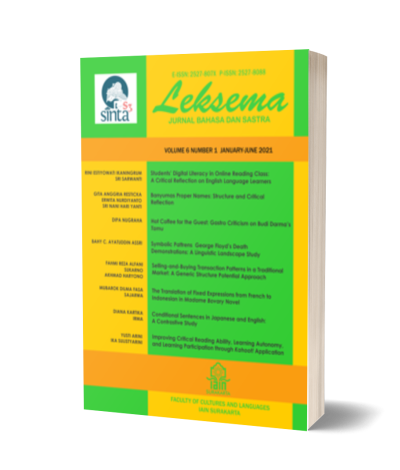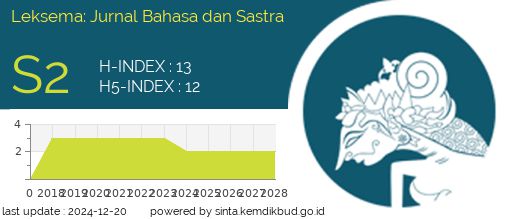THE APPRAISAL SYSTEM OF HYPERBOLIC EXPRESSIONS IN SETIYONO'S 'GLONGGONG' NOVEL TRILOGY
DOI:
https://doi.org/10.22515/ljbs.v7i2.5765Keywords:
hyperbole, figurative language, appraisal systemAbstract
This study aimed to find out the appraisal system in the hyperbolic figure of speech. is a qualitative-descriptive study with data in the forms of words, phrases, and clauses indicating hyperbolic figurative language and having appraisal systems. The sources of data were the novel trilogy entitled Glonggong that consists of Glonggong, Arumdalu, and Dasamuka. For collecting the data, focus group discussion and content analysis were applied, whereas for analyzing the data, it used Spradley’s Ethnography Method comprising domain, taxonomy, componential, and cultural theme analysis consecutively. The result of this study show that hyperboles as a type of figurative language in the narratives and dialogues of the novel have appraisal systems in the forms of attitude, graduation, and source.
Downloads
References
Aminuddin. 1997. Stilistika: Pengantar Memahami Bahasa dalam Karya Sastra. Semarang: IKIP Semarang Press
Keraf, Gorys. 2004. Komposisi: Sebuah Pengantar Kemahiran Bahasa. Flores: Nusa Indah
Lincoln, Yvonna S & Egon G Guba. 1985. Naturalistic Inquiry. California: Sage
Martin, James R & David Rose. 2007. Working with Discourse. London: Continuum
Martin, James R & Peter RR White. 2005. The Language of Evaluation: Appraisal in English. New York: Palgrave Macmillan
Ratna, Nyoman Kutha. 2017. Stilistika: Kajian Puitika Bahasa, Sastra, dan Budaya. Yogyakarta: Pustaka Pelajar
Spradley, James P. 1980. Participant Observation. USA: Holt, Rinehart, and Winston
Sudjiman, Panuti. 1993. Bunga Rampai Stilistik. Jakarta: Pustaka Utama Grafiti
Sugiyono. 2016. Metode Penelitian Kuantitatif, Kualitatif dan R&D. Bandung: Alfabeta
Sutopo, HB. 2002. Metodologi Penelitian Kualitatif: Teori dan Aplikasinya dalam Penelitian. Surakarta: Universitas Sebelas Maret
Nainggolan, Febriani, Dwike Agustina Siahaan, Bloner Sinurat & Herman. 2021. “An Analysis of Figurative Language on Joe Biden's Victory Speech”. International Journal on Integrated Education 4 (3): 364-375
Supianti, Rita, Suhardi & Dwi Lestari. 2020. “Bentuk Majas dalam Novel Origami Hati Karya Boy Candra dan Implementasi dalam Pembelajaran Bahasa Indonesia di Sekolah Menengah Pertama”. Student Online Journal (SOJ) UMRAH - Keguruan dan Ilmu Pendidikan 1(2): 162-170
Rahma, Miladia & Atiqa Sabardila. 2022. “Majas dalam Cerita Fanfiction oleh Penggemar K-Pop di Aplikasi Wattpad”. Basindo: Jurnal Kajian Bahasa, Sastra Indonesia, dan Pembelajarannya 6 (2): 241-258
Rosdiana, Lilis Amaliah. 2017. “Majas dalam Novel Seperti Dendam, Rindu Harus Dibayar Tuntas Karya Eka Kurniawan: Tinjauan Stilistika”. Alinea: Jurnal Bahasa, Sastra, dan Pengajaran. 6 (2): 64-69
Sutopo, Bekti. 2014. “Hiperbola dan Simile dalam Novel Mukenah & Sajadah untuk Soya Karya Maria Bo Niok: Kajian Stilistika”. Sasindo: Jurnal Pendidikan Bahasa dan Sastra Indonesia 2 (1): 109-121
Downloads
Published
Issue
Section
License
Copyright (c) 2022 Leksema: Jurnal Bahasa dan Sastra

This work is licensed under a Creative Commons Attribution-NonCommercial-ShareAlike 4.0 International License.
The copyright of the received article shall be assigned to the publisher of the journal. The intended copyright includes the right to publish the article in various forms (including reprints). The journal maintains the publishing rights to published articles.
In line with the license, the authors and users (readers or other researchers) are allowed to share and adapt the material only for non-commercial purposes. In addition, the material must be given appropriate credit, provided with a link to the license, and indicated if changes were made. If authors remix, transform or build upon the material, authors must distribute their contributions under the same license as the original.







